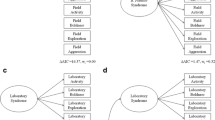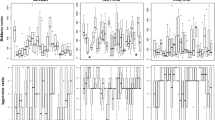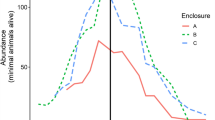Abstract
The development and persistence of personality in nature are counterintuitive because, in heterogeneous environments, personality is expected to limit the degree of behavioural flexibility. Recent work has shown that personality and behavioural flexibility might be linked, but their interaction is not well understood and could be elucidated by studying a socially flexible species. Using well-established tests, we measured the personality traits of activity, boldness, exploration and aggressiveness in free-living striped mice (Rhabdomys pumilio) in South Africa. Specifically, we tested whether personality changes when individuals change their reproductive tactic, either from group-living philopatrics to solitary-living females and roaming males or from non-breeding philopatrics to breeders. Our results showed that striped mice have personalities: Individuals behaved consistently for all the behavioural traits measured both over time and contexts (breeding to non-breeding season). While most of the personality traits measured remained consistent among tactics, they did not predict which tactic an individual would adopt next, suggesting that environmental conditions rather than personality influence tactic switching. Additionally, we found important differences in the consistency of the behaviours measured between males and females, indicating that sexual selection might play a prominent role in the maintenance of personality in this species. Our study demonstrates that some personality traits can be stable over an entire lifetime even in socially flexible species and that personality does not constrain social flexibility.




Similar content being viewed by others
References
Arnold C, Taborsky B (2010) Social experience in early ontogeny has lasting effects on social skills in cooperatively breeding cichlids. Anim Behav 79:621–630
Bates D, Mächler M, Bolker BM, Walker SC (2014) Fitting linear mixed-effects models using lme4, http://CRAN.R-project.org/package=lme4
Bell AM (2007) Future directions in behavioural syndromes research. Proc R Soc Lond B 274:755–761
Bell AM, Sih A (2007) Exposure to predation generates personality in threespined sticklebacks (Gasterosteus aculeatus). Ecol Lett 10:828–834
Bell AM, Hankison SJ, Laskowski KL (2009) The repeatability of behaviour: a meta-analysis. Anim Behav 77:771–783
Belthoff JR, Dufty AM (1998) Corticosterone, body condition and locomotor activity: a model for dispersal in screech-owls. Anim Behav 55:405–415
Benus RF, Rondigs M (1996) Patterns of maternal effort in mouse lines bidirectionally selected for aggression. Anim Behav 51:67–75
Birke LIA, Archer J (1983) Some issues and problems in the study of animal exploration. In: Archer J, Birke LIA (eds) Exploration in animals and humans. Nostrand, New York, pp 1–21
Biro PA, Stamps SA (2008) Are animal personality traits linked to life-history productivity? Trends Ecol Evol 23:361–368
Boon AK, Réale D, Boutin S (2007) The interaction between personality, offspring fitness and food abundance in North American red squirrels. Ecol Lett 10:1094–1104
Boon AK, Réale D, Boutin S (2008) Personality, habitat use, and their consequences for survival in North American red squirrels Tamiasciurus hudsonicus. Oikos 117:1321–1328
Briffa M, Rundle SD, Fryer A (2008) Comparing the strength of behavioural plasticity and consistency across situations: animal personalities in the hermit crab. Pagurus bernhardus. Proc R Soc Lond B 275:1305–1311
Careau V, Thomas D, Humphris MM, Réale D (2008) Energy metabolism and animal personality. Oikos 117:641–653
Carter AJ (2013) On validity and controls in animal personality research: a comment on Galhardo et al. (2012). Biol Lett 9: 20121080
Carter AJ, Feeney WE, Marshall HH, Cowlishaw G, Heinsohn R (2012a) Animal personality: what are behavioural ecologists measuring? Biol Rev 88:465–475
Carter AJ, Marshall HH, Heinsohn R, Cowlishaw G (2012b) Evaluating animal personalities: do observer assessments and experimental tests measure the same thing? Behav Ecol Sociobiol 66:153–160
Chapman BB, Hegg A, Ljungberg P (2013) Sex and the syndrome: individual and population consistency in behaviour in rock pool prawn Palaemon elegans. PLoS One 8, e59437
Cote J, Clobert J (2007) Social personalities influence natal dispersal in a lizard. Proc R Soc Lond B 274:383–390
Crawley MJ (2007) The R Book. Wiley, Chichester
Crusio WE (2001) Genetic dissection of mouse exploratory behaviour. Behav Brain Res 125:127–132
Dall SRX, Houston AI, McNamara JM (2004) The behavioural ecology of personality: consistent individual differences from an adaptive perspective. Ecol Lett 7:734–739
Dammhan M (2012) Are personality differences in a small iteroparous mammal maintained by a life-history trade-off? Proceedings of the Royal Society B 279: 2645–2651
DeWitt TJ, Sih A, Wilson DS (1998) Costs and limits of phenotypic plasticity. Trends Ecol Evol 13:77–81
Dingemanse NJ, Both C, van Noordwijk AJ, Rutten AL, Drent PJ (2003) Natal dispersal and personalities in great tits (Parus major). Proc R Soc Lond B 270:741–747
Dingemanse NJ, Wright J, Kazem AJN, Thomas DK, Hickling R, Dawnay N (2007) Behavioural syndromes differ predictably between populations of three-spined stickleback. J Anim Ecol 76:1128–1138
Dingemanse NJ, Kazem AJN, Réale D, Wright J (2009) Behavioural reaction norms: where animal personality meets individual plasticity. Trends Ecol Evol 25:81–89
Dingemanse NJ, Bouwman KM, van de Pol M, van Overveld T, Patrick SM, Matthysen E, Quinn JL (2010) Variation in personality and behavioural plasticity across four populations of the great tit Parus major. J Anim Ecol 81:116–126
Dudycha GJ (1936) An objective study of punctuality in relation to personality and achievement. Arch Psychol 204:1–53
Gamer M, Lemon J, Fellows I, Singh P (2012) irr: various coefficients of interrater reliability and agreement, http://CRAN.R-project.org/package=irr
Gosling SD (2001) From mice to men: what can we learn about personality from animal research. Psychol Bull 127:45–86
Gosling SD, John OP (1999) Personality dimensions in nonhuman animals: a cross-species review. Curr Dir Psychol Sci 8:69–75
Greenberg R (1984) Neophobia in the foraging-site selection of a neotropical migrant bird: an experimental study. Proc Natl Acad Sci U S A 81:3778–3780
Gyuris E, Feró O, Tartally A, Barta Z (2011) Individual behaviour in firebugs (Pyrrhocoris apterus). Proc R Soc Lond B 278:628–633
Hazlett BA (1995) Behavioral plasticity in crustacea: why not more? J Exp Mar Biol Ecol 193:57–66
Herde A, Eccard JA (2013) Consistency in boldness, activity nd exploration at different stages of life. BMC Ecology 1:49
Holekamp KE (1986) Proximal causes of natal dispersal in Belding’s ground squirrels (Spermophilus beldingi). Ecol Monogr 56:365–391
Hoset KS, Ferchaud AL, Dufour F, Mersch D, Cote J, Le Galliard JF (2011) Natal dispersal correlates with behavioral traits that are not consistent across early life stages. Behav Ecol 22:176–183
Howell S, Westergaard G, Hoos B, Chavanne TJ, Shoaf SE, Cleveland A, Snoy PJ, Suomi SJ, Higley JD (2007) Serotonergic influences on life history outcomes in free-ranging male rhesus Macaques. Am J Primatol 69:851–865
Jackman S (2008) pscl: classes and methods for R developed in the political science computational laboratory, Stanford University, URL http://CRAN.R-project.org/package=pscl
Johnson JC, Sih A (2007) Fear, food, sex and parental care: a syndrome of boldness in the fishing spider, Dolomedes triton. Anim Behav 74:1131–1138
Kaplan JR, Fontenot MB, Berard J, Manuck SB, Mann JJ (1995) Delayed dispersal and elevated monoaminergic activity in free-ranging rhesus monkeys. Am J Primatol 35:229–234
Kluen E, Brommer JE (2013) Context-specific repeatability of personality traits in a wild bird: a reaction-norm perspective. Behav Ecol 24:650–658
Komdeur J (2006) Variation in individual investment strategies among social animals. Ethology 112:729–747
Koolhaas JM, Korte SM, de Boer SF, van der Vegt BJ, Van Reenen CG, Hopster H, de Jong IC, Ruis MAW, Blokhuis HJ (1999) Coping styles in animals: current status in behavior and stress-physiology. Neurosci Biobehav R 23:925–935
Le Vin AL, Mable BK, Taborsky M, Heg D, Arnold KE (2011) Individual variation in helping in a cooperative breeder: relatedness versus behavioural type. Anim Behav 82:467–477
Legendre P (2005) Species associations: Kendall coefficient of concordance revisited. J Agric Biol Environ Stat 10:226–245
Martin P, Bateson P (1993) Measuring behaviour: an introductory guide, 2nd edn. Cambridge University Press, Cambridge
Martin JGA, Réale D (2008) Temperament, risk assessment and habituation to novelty in eastern chipmunks, Tamias striatus. Anim Behav 75:309–318
Martin JGA, Nussey DH, Wilson AJ, Réale D (2011) Measuring individual differences in reaction norms in field and experimental studies: a power analysis of random regression models. Methods Ecol Evol 2:362–374
McNamara JM, Stephens PA, Dall SRX, Houston AI (2009) Evolution of trust and trustworthiness: social awareness favours personality differences. Proc R Soc Lond B 276:605–661
Mischel W (2004) Towards an integrative science of the person. Annu Rev Psychol 55:1–22
Montiglio PO, Garant D, Bergeron P, Messier GD, Reale D (2014) Pulsed resources and the coupling between life-history strateies d exploration patterns in eastern chipmunks. J Anim Ecol 83:720–728
Myers JH, Krebs CJ (1971) Genetic, behavioral, and reproductive attributes of dispersing field voles Microtus pennsylvanicus and Microtus ochrogaster. Ecol Monogr 41:53–78
Nakagawa S, Schielzeth H (2010) Repeatability for Gaussian and non-Gaussian data: a practical guide for biologists. Biol Rev 85:935–956
Nussey DH, Wilson AJ, Brommer JE (2007) The evolutionary ecology of individual phenotypic plasticity in wild populations. J Evol Biol 20:831–844
Piersma T, Drent J (2003) Phenotypic flexibility and the evolution of organismal design. Trends Ecol Evol 18:228–233
Pigliucci M (2005) Evolution of phenotypic plasticity: where are we going now? Trends Ecol Evol 20:481–486
Pillay N (2000) Female mate preference and reproductive isolation in populations of the striped mouse Rhabdomys pumilio. Behaviour 137:1431–1441
Réale D, Reader SM, Sol D, McDougall PT, Dingemanse NJ (2007) Integrating animal temperament within ecology and evolution. Biol Rev 82:291–318
Réale D, Dingemanse NJ, Kazem AJN, Wright J (2010) Evolutionary and ecological approaches to the study of personality. Philos T R Soc B 365:3937–3946
Schjolden J, Winberg S (2007) Genetically determined variation in stress responsiveness in rainbow trout: behavior and neurobiology. Brain Behav Evol 70:227–238
Schoepf I, Schradin C (2012a) Better off alone! Reproductive competition and ecological constraints determine sociality in the African striped mouse (Rhabdomys pumilio). J Anim Ecol 81:649–656
Schoepf I, Schradin C (2012b) Differences in social behaviour between group-living and solitary African striped mice, Rhabdomys pumilio. Anim Behav 84:1159–1167
Schradin C (2004) Territorial defense in a group living solitary forager: who, where, against whom? Behav Ecol Sociobiol 55:439–446
Schradin C (2005) When to live alone and when to live in groups: ecological determinants of sociality in the African striped mouse (Rhabdomys pumilio, Sparrman, 1784). Belg J Zool 135:77–82
Schradin C (2006) Whole-day follows of striped mice (Rhabdomys pumilio), a diurnal murid rodent. J Ethol 24:37–43
Schradin C, Pillay N (2004) The striped mouse (Rhabdomys pumilio) from the Succulent Karoo, South Africa: a territorial group-living solitary forager with communal breeding and helpers at the nest. J Comp Psychol 118:37–47
Schradin C, Pillay N (2005) Intraspecific variation in spatial and social organization of the African striped mouse. J Mammal 86:99–107
Schradin C, Pillay N (2014) Absence of reproductive suppression in young adult female striped mice living in their natal family. Anim Behav 90:141–148
Schradin C, Schubert M, Pillay N (2006) Winter huddling groups in the striped mouse. Can J Zool 117:317–324
Schradin C, Scantlebury M, Pillay N, König B (2009a) Testosterone levels in dominant sociable males are lower than in solitary roamers: physiological differences between three male reproductive tactics in a sociably flexible mammal. Am Nat 173:376–388
Schradin C, Schneider C, Yuen CH (2009b) Age at puberty in male African striped mice: the impact of food, population density and the presence of the father. Funct Ecol 23:1004–1013
Schradin C, König B, Pillay N (2010a) Reproductive competition favours solitary living while ecological constraints impose group-living in African striped mice. J Anim Ecol 79:515–522
Schradin C, Schneider C, Lindholm AK (2010b) The nasty neighbour in the striped mouse (Rhabdomys pumilio) steals paternity and elicits aggression. Front Zool 7:19
Schradin C, Lindholm AK, Johannesen J, Schoepf I, Yuen CH, König B, Pillay N (2012) Social flexibility and social evolution in mammals: a case study of the African striped mouse (Rhabdomys pumilio). Mol Ecol 21:541–553
Schuett W, Tregenza T, Dall SR (2010) Sexual selection and animal personality. Biol Rev 85:217–246
Schuett W, Dall SRX, Baeumer J, Kloesener MH, Nakagawa S, Beinlich F, Eggers T (2011) “Personality” variation in a clonal insect: the Pea Aphid, Acyrthosiphon pisum. Dev Psychobiol 53:631–640
Sih A, Bell AM (2008) Insights for behavioral ecology from behavioral syndromes. Adv Stud Behav 38:227–281
Sih A, Bell AM, Johnson JC (2004a) Behavioral syndromes: an ecological and evolutionary overview. Trends Ecol Evol 19:372–378
Sih A, Bell AM, Johnson JC, Ziemba RE (2004b) Behavioral syndromes: an integrative overview. Q Rev Biol 79:2410–277
Stamps J, Groothuis TGG (2010) The development of animal personality: relevance, concepts and perspectives. Biol Rev 85:301–325
Tebbich S, Fessl B, Blomqvist D (2009) Exploration and ecology in Darwin's finches. Evol Ecol 23:591–605
Verbeek MEM, Drent PJ, Wiepkema PR (1994) Consistent individual differences in early exploratory behaviour of male great tits. Anim Behav 48:1113–1121
Via S, Lande R (1985) Genotype-environment interaction and the evolution of phenotypic plasticity. Evolution 39:505–523
Via S, Gomulkiewicz R, de Jong G, Scheiner SM, Schlichting CD, van Tienderen PH (1995) Adaptive phenotypic plasticity - consensus and controversy. Trends Ecol Evol 10:212–217
Wilson RC, Vacek T, Lanier DL, Dewsbury DA (1976) Open-field behaviour in muroid rodents. Behav Biol 17:495–506
Wolf M, van Doorn GS, Leimar O, Weissing FJ (2007) Life-history trade offs favour the evolution of animal personalities. Nature 447:581–585
Wolf M, van Doorn GS, Weissing FJ (2008) Evolutionary emergence of responsive and unresponsive personalities. Proc Natl Acad Sci U S A 105:15825–15830
Zimbardo PG (1995) Psychologie. Springer, Berlin
Zuur AF, Ieno EN, Walker NJ, Saveliev AA, Smith GM (2009) Mixed effects models and extensions in ecology with R. In: Gail M, Krickeberg K, Samet JM, Tsiatis A, Wong W (eds) Springer, New York, USA
Acknowledgments
This study was made possible by the administrative and technical support of the Succulent Karoo Research Station (registered South African NPO 122–134), at which field site, the data were collected. We are thankful to the Department of Tourism, Environment and Conservation of the Northern Cape for issuing research permits. We extend warm thanks to the manager and staff of the Goegap Nature Reserve for allowing us to collect data on striped mice within the reserve. We are grateful to several field assistants and honour students for their help with data collection. We are very grateful to Prof. Hayes and two other anonymous reviewers for their comments, which we believe have greatly improved our paper. The Cogito Foundation, National Research Foundation (grant number 87769) and University of the Witwatersrand provided the funding for the project.
Ethical standards
Fieldwork for this study was carried out under the necessary licenses and was in accordance with the relevant animal welfare regulations. We received ethical clearance from the Animal Ethics Committee and the University of the Witwatersrand (AESC: 2007/38/04).
Conflict of interest
The authors declare that they have no conflict of interest.
Author information
Authors and Affiliations
Corresponding author
Additional information
Communicated by C. Soulsbury
Rights and permissions
About this article
Cite this article
Yuen, C.H., Pillay, N., Heinrichs, M. et al. Personality does not constrain social and behavioural flexibility in African striped mice. Behav Ecol Sociobiol 69, 1237–1249 (2015). https://doi.org/10.1007/s00265-015-1937-6
Received:
Revised:
Accepted:
Published:
Issue Date:
DOI: https://doi.org/10.1007/s00265-015-1937-6




